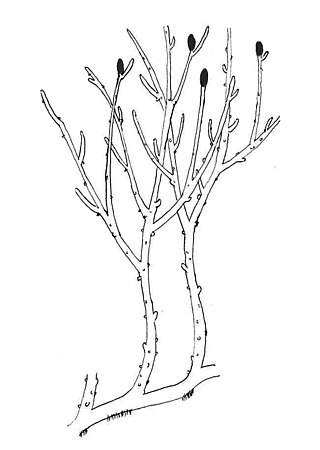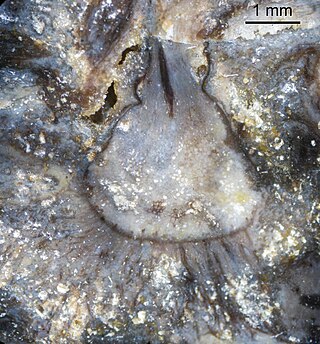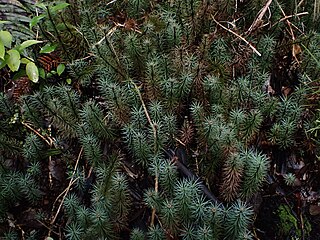Related Research Articles

A gametophyte is one of the two alternating multicellular phases in the life cycles of plants and algae. It is a haploid multicellular organism that develops from a haploid spore that has one set of chromosomes. The gametophyte is the sexual phase in the life cycle of plants and algae. It develops sex organs that produce gametes, haploid sex cells that participate in fertilization to form a diploid zygote which has a double set of chromosomes. Cell division of the zygote results in a new diploid multicellular organism, the second stage in the life cycle known as the sporophyte. The sporophyte can produce haploid spores by meiosis that on germination produce a new generation of gametophytes.

Plant cells are the cells present in green plants, photosynthetic eukaryotes of the kingdom Plantae. Their distinctive features include primary cell walls containing cellulose, hemicelluloses and pectin, the presence of plastids with the capability to perform photosynthesis and store starch, a large vacuole that regulates turgor pressure, the absence of flagella or centrioles, except in the gametes, and a unique method of cell division involving the formation of a cell plate or phragmoplast that separates the new daughter cells.

Xylem is one of the two types of transport tissue in vascular plants, the other being phloem. The basic function of the xylem is to transport water from roots to stems and leaves, but it also transports nutrients. The word xylem is derived from the Ancient Greek word ξύλον (xylon), meaning "wood"; the best-known xylem tissue is wood, though it is found throughout a plant. The term was introduced by Carl Nägeli in 1858.

Vascular plants, also called tracheophytes or collectively tracheophyta, form a large group of land plants that have lignified tissues for conducting water and minerals throughout the plant. They also have a specialized non-lignified tissue to conduct products of photosynthesis. Vascular plants include the clubmosses, horsetails, ferns, gymnosperms, and angiosperms. Scientific names for the group include Tracheophyta, Tracheobionta and Equisetopsida sensu lato. Some early land plants had less developed vascular tissue; the term eutracheophyte has been used for all other vascular plants, including all living ones.

In biology, tissue is an assembly of similar cells and their extracellular matrix from the same embryonic origin that together carry out a specific function. Tissues occupy a biological organizational level between cells and a complete organ. Accordingly, organs are formed by the functional grouping together of multiple tissues.
A tracheid is a long and tapered lignified cell in the xylem of vascular plants. It is a type of conductive cell called a tracheary element. Angiosperms use another type of conductive cell, called vessel elements, to transport water through the xylem. The main functions of tracheid cells are to transport water and inorganic salts, and to provide structural support for trees. There are often pits on the cell walls of tracheids, which allows for water flow between cells. Tracheids are dead at functional maturity and do not have a protoplast. The wood (softwood) of gymnosperms such as pines and other conifers is mainly composed of tracheids. Tracheids are also the main conductive cells in the primary xylem of ferns.

The Rhynie chert is a Lower Devonian sedimentary deposit exhibiting extraordinary fossil detail or completeness. It is exposed near the village of Rhynie, Aberdeenshire, Scotland; a second unit, the Windyfield chert, is located some 700 m away. The Rhynie chert contains exceptionally preserved plant, fungus, lichen and animal material preserved in place by an overlying volcanic deposit. The bulk of the Devonian fossil bed consists of primitive plants, along with arthropods, lichens, algae and fungi.

A vessel element or vessel member is one of the cell types found in xylem, the water conducting tissue of plants. Vessel elements are found in most angiosperms but absent from most gymnosperms such as conifers. Vessel elements are the main feature distinguishing the "hardwood" of angiosperms from the "softwood" of conifers.

Asteroxylon is an extinct genus of vascular plants of the Division Lycopodiophyta known from anatomically preserved specimens described from the famous Early Devonian Rhynie chert and Windyfield chert in Aberdeenshire, Scotland. Asteroxylon is considered a basal member of the Lycopsida.

The rhyniophytes are a group of extinct early vascular plants that are considered to be similar to the genus Rhynia, found in the Early Devonian. Sources vary in the name and rank used for this group, some treating it as the class Rhyniopsida, others as the subdivision Rhyniophytina or the division Rhyniophyta. The first definition of the group, under the name Rhyniophytina, was by Banks, since when there have been many redefinitions, including by Banks himself. "As a result, the Rhyniophytina have slowly dissolved into a heterogeneous collection of plants ... the group contains only one species on which all authors agree: the type species Rhynia gwynne-vaughanii". When defined very broadly, the group consists of plants with dichotomously branched, naked aerial axes ("stems") with terminal spore-bearing structures (sporangia). The rhyniophytes are considered to be stem group tracheophytes.
A leptoid is a type of elongated food-conducting cell like phloem in the stems of some mosses, such as the family Polytrichaceae. They surround strands of water-conducting hydroids. They have some structural and developmental similarities to the sieve elements of seedless vascular plants. At maturity they have inclined end cell walls with small pores and degenerate nuclei. The conduction cells of mosses, leptoids and hydroids, appear similar to those of fossil protracheophytes. However they're not thought to represent an intermediate stage in the evolution of plant vascular tissues but to have had an independent evolutionary origin.

The evolution of plants has resulted in a wide range of complexity, from the earliest algal mats of unicellular archaeplastids evolved through endosymbiosis, through multicellular marine and freshwater green algae, to spore-bearing terrestrial bryophytes, lycopods and ferns, and eventually to the complex seed-bearing gymnosperms and angiosperms of today. While many of the earliest groups continue to thrive, as exemplified by red and green algae in marine environments, more recently derived groups have displaced previously ecologically dominant ones; for example, the ascendance of flowering plants over gymnosperms in terrestrial environments.

Polysporangiophytes, also called polysporangiates or formally Polysporangiophyta, are plants in which the spore-bearing generation (sporophyte) has branching stems (axes) that bear sporangia. The name literally means 'many sporangia plant'. The clade includes all land plants (embryophytes) except for the bryophytes whose sporophytes are normally unbranched, even if a few exceptional cases occur. While the definition is independent of the presence of vascular tissue, all living polysporangiophytes also have vascular tissue, i.e., are vascular plants or tracheophytes. Extinct polysporangiophytes are known that have no vascular tissue and so are not tracheophytes.

Aglaophyton major was the sporophyte generation of a diplohaplontic, pre-vascular, axial, free-sporing land plant of the Lower Devonian. It had anatomical features intermediate between those of the bryophytes and vascular plants or tracheophytes.

Rhynia is a single-species genus of Devonian vascular plants. Rhynia gwynne-vaughanii was the sporophyte generation of a vascular, axial, free-sporing diplohaplontic embryophytic land plant of the Early Devonian that had anatomical features more advanced than those of the bryophytes. Rhynia gwynne-vaughanii was a member of a sister group to all other eutracheophytes, including modern vascular plants.

Horneophyton is an extinct early plant which may form a "missing link" between the hornworts and the Rhyniopsida. It is a member of the class Horneophytopsida. Horneophyton is among the most abundant fossil organisms found in the Rhynie chert, a Devonian Lagerstätte in Aberdeenshire, UK. A single species, Horneophyton lignieri, is known. Its probable female gametophyte is the form taxon Langiophyton mackiei.

Ventarura is a genus of extinct vascular plants of the Early Devonian. Fossils were found in the Windyfield chert, Rhynie, Scotland. Some features, such as bivalved sporangia borne laterally and the anatomy of the xylem, relate this genus to the zosterophylls. Other features are unclear due to poor preservation.

Dawsonia is a genus of acrocarpous mosses. Dawsonia, along with other members of the order Polytrichales, are taller than most mosses and have thicker leaves. Their sporophytes have conducting systems analogous to those of vascular plants. Dawsonia superba is found in New Zealand, Australia and New Guinea. D. longifolia is found in the Philippines, Indonesia, Malaysia, and Australia. There is uncertainty as to whether D. superba and D. longifolia are actually distinct species.

Dawsonia superba is a moss in the family Polytrichaceae that is found in Australia, New Guinea, Malaysia and New Zealand. D. superba is the tallest self-supporting moss in the world, reaching heights of 60 cm (24 in). It has analogous structures to those in vascular plants that support large size, including hydroid and leptoid cells to conduct water and photosynthate, and lamellae that provide gas chambers for more efficient photosynthesis. D. superba is a member of the class Polytrichopsida, although it has a sporophyte that is unique from other hair-cap mosses.

Polytrichastrum formosum, commonly known as the bank haircap moss, is a species of moss belonging to the family Polytrichaceae.
References
- ↑ Mishler, Brent D.; Churchill, Steven P. (1984). "A Cladistic Approach to the Phylogeny of the "Bryophytes"". Brittonia. 36 (4): 406–24. Bibcode:1984Britt..36..406M. doi:10.2307/2806602. ISSN 0007-196X. JSTOR 2806602. S2CID 85185192.
- ↑ Schofield, Wilfred Borden. "Bryophyte: Form and function". Encyclopædia Britannica. Retrieved 2012-12-17.
- ↑ Edwards, David S. (1986), "Aglaophyton major, a non-vascular land-plant from the Devonian Rhynie Chert", Botanical Journal of the Linnean Society, 93 (2): 173–204, doi:10.1111/j.1095-8339.1986.tb01020.x